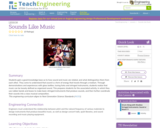
Music can loosely be defined as organized sound. The lesson objectives, understanding sound is a form of energy, understanding pitch, understanding sound traveling through a medium, and being able to separate music from sound, can provide a good knowledge base as to how sound, math, and music are related. Sound exists everywhere in the world; typically objects cause waves of pressure in the air which are perceived by people as sound. Among the sounds that exist in everyday life, a few of them produce a definite pitch. For example, blowing air over half full glass bottles, tapping a glass with a spoon, and tapping long steel rods against a hard surface all produce a definite pitch because a certain component of the object vibrates in a periodic fashion. The pitch produced by an object can be changed by the length or the volume of the portion that vibrates. For example, by gradually filling a bottle while blowing across the top, higher pitches can be generated. By organizing a few of these sounds with a clearer pitch, the sounds become closer to music. The very first musical instruments involved using various objects (e.g. bells) that have different pitches, which are played in sequence. The organization of the pitches is what transforms sounds into music. Since the first instruments, the ability to control pitch has greatly improved as illustrated by more modern instruments such as guitars, violins, pianos, and more. Music is comprised of organized sound, which is made of specific frequencies. This lesson will help define and elaborate on the connections between sound and music.
- Subject:
- Applied Science
- Engineering
- Physical Science
- Physics
- Material Type:
- Activity/Lab
- Lesson Plan
- Provider:
- TeachEngineering
- Provider Set:
- TeachEngineering
- Author:
- Daniel Choi
- Date Added:
- 09/18/2014
